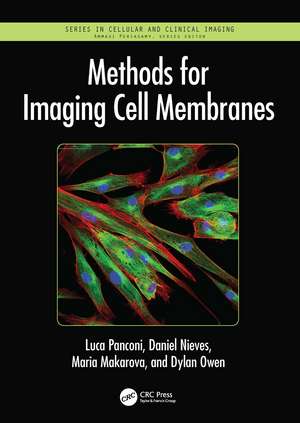Methods for Imaging Cell Membranes: Series in Cellular and Clinical Imaging
Autor Luca Panconi, Daniel Nieves, Maria Makarova, Dylan Owenen Limba Engleză Hardback – 21 dec 2023
There are numerous methods employed to understand cell membrane organisation, but foremost among them are microscopy methods which can map the distributions of molecules on the cell surface and even map the biophysical properties of membranes themselves. Fluorescence microscopy has been especially widely used due to its specificity and relatively noninvasive nature, allowing live-cell imaging. However, the recent advance of super-resolution fluorescence microscopy has broken the previous resolution limit for this type of microscopy, which has been an important advancement in the field. Atomic force microscopy and electron microscopy have also been deployed to learn about membrane organisation and properties.
Each chapter in this volume will be themed around measuring a particular property of cell membranes. In each case, the authors examine the range of methodology applicable to the task, comparing the advantages and disadvantages of each one, and will also provide an overview of important discoveries that have been made using the methodology being discussed. The chapters will cover:
- Measuring membrane protein distributions using single-molecule localisation microscopy (SMLM)
- Measuring membrane protein dynamics and diffusion using fluorescence correla-tion spectroscopy (FCS)
- Mapping membrane lipid backing using environmentally sensitive fluorescence probes
- Mapping membrane thickness and rigidity using atomic force microscopy
- Mapping membrane proteins and the cytoskeleton using electron microscopy
Preț: 779.63 lei
Preț vechi: 950.76 lei
-18% Nou
Puncte Express: 1169
Preț estimativ în valută:
149.20€ • 154.13$ • 124.17£
149.20€ • 154.13$ • 124.17£
Carte tipărită la comandă
Livrare economică 26 martie-09 aprilie
Preluare comenzi: 021 569.72.76
Specificații
ISBN-13: 9781032207902
ISBN-10: 1032207906
Pagini: 136
Ilustrații: 4 Line drawings, color; 13 Line drawings, black and white; 8 Halftones, black and white; 4 Illustrations, color; 21 Illustrations, black and white
Dimensiuni: 156 x 234 x 10 mm
Greutate: 0.37 kg
Ediția:1
Editura: CRC Press
Colecția CRC Press
Seria Series in Cellular and Clinical Imaging
ISBN-10: 1032207906
Pagini: 136
Ilustrații: 4 Line drawings, color; 13 Line drawings, black and white; 8 Halftones, black and white; 4 Illustrations, color; 21 Illustrations, black and white
Dimensiuni: 156 x 234 x 10 mm
Greutate: 0.37 kg
Ediția:1
Editura: CRC Press
Colecția CRC Press
Seria Series in Cellular and Clinical Imaging
Public țintă
Postgraduate and Undergraduate AdvancedCuprins
Chapter 1. General introduction to imaging the Plasma membrane
Chapter 2. How to map membrane proteins at the single-molecule level
Chapter 3. Measuring diffusion of membrane biomolecules using fluorescence microscopy
Chapter 4. Detecting membrane protein dimers and oligomers by FRET
Chapter 5. Imaging membrane biophysical properties
Chapter 6. Conclusions and future perspectives
Notă biografică
Luca Panconi is a mathematician and bioinformatician who specialises in implementing analysis techniques for super-resolution microscopy data. His work crosses the boundaries of computer science and biology, creating innovative data analysis tools that unlock unprecedented details at a molecular level. As a statistician with a commitment to advancing the scientific community, his work bridges the gap between complex mathematics and biological research.
Dr. Daniel Nieves has been a research fellow in the lab of Prof. Dylan Owen within the Institute of Immunology and Immunotherapy at the University of Birmingham, UK since 2019. His work has focused on implementation and design of a framework to aid cluster analysis implementation for single molecule localisation microscopy. His research focuses on the development of new labelling and analysis methods to improve quantitative biological measurements using super-resolution microscopy.
Dr. Maria Makarova was promoted to Assistant Professor in 2022 in the School of Biosciences. Her work combines comparative microbiology, genetics, lipidomics and advanced microscopy to understand the interplay of metabolism, the membrane and the environment.
Prof. Dylan Owen moved to the University of Birmingham in 2019 and now holds an interdisciplinary chair position between the Institute of Immunology and Immunotherapy and the School of Mathematics, as well as serving as the deputy-director of the Centre of Membrane Proteins and Receptors (COMPARE). His lab’s work seeks to develop new microscopy methodology (especially single-molecule localisation microscopy, image analysis and AI) and apply these methods to study membrane biophysics and T cell immunology.
Dr. Daniel Nieves has been a research fellow in the lab of Prof. Dylan Owen within the Institute of Immunology and Immunotherapy at the University of Birmingham, UK since 2019. His work has focused on implementation and design of a framework to aid cluster analysis implementation for single molecule localisation microscopy. His research focuses on the development of new labelling and analysis methods to improve quantitative biological measurements using super-resolution microscopy.
Dr. Maria Makarova was promoted to Assistant Professor in 2022 in the School of Biosciences. Her work combines comparative microbiology, genetics, lipidomics and advanced microscopy to understand the interplay of metabolism, the membrane and the environment.
Prof. Dylan Owen moved to the University of Birmingham in 2019 and now holds an interdisciplinary chair position between the Institute of Immunology and Immunotherapy and the School of Mathematics, as well as serving as the deputy-director of the Centre of Membrane Proteins and Receptors (COMPARE). His lab’s work seeks to develop new microscopy methodology (especially single-molecule localisation microscopy, image analysis and AI) and apply these methods to study membrane biophysics and T cell immunology.
Descriere
This book will serve as an introduction to microscopy and biomedical imaging methods, focussed on the study of the distributions and dynamics of molecules on the cell surface.






